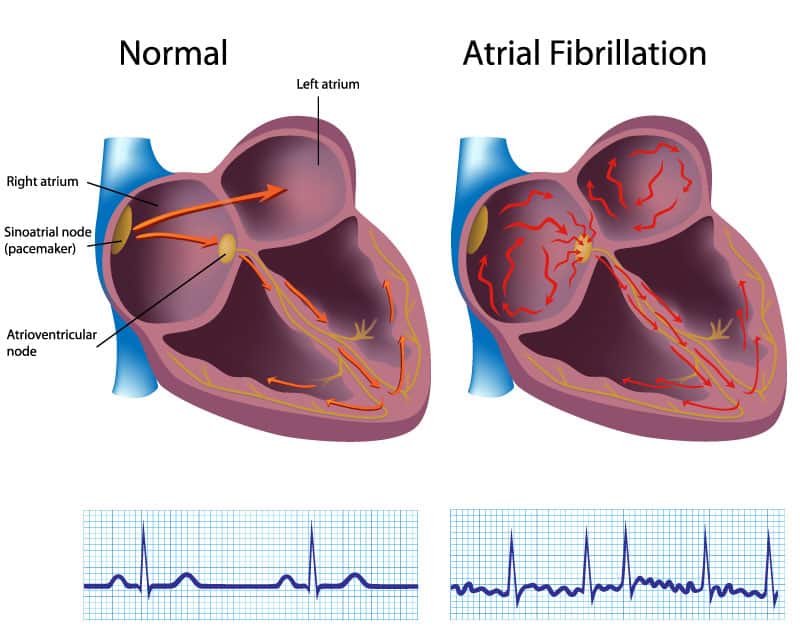Atrial fibrillation (AFib) is a common disorder of the normal rhythm of the heart (also known as sinus rhythm). It is characterized by a rapid and irregular heartbeat, largely due to abnormal electrical impulses that cause the two upper chambers of the heart (atria) to quiver when they should be beating steadily. This also causes fast and erratic contraction of the ventricles that the patient feels as chest palpitations.
Because of AFib, blood flow is reduced and is not completely pumped out of the atria. This negatively impacts cardiac performance and also allows blood to pool and potentially clot (thrombus), especially in the left atrial appendage. These clots, if freed (embolus), can enter the systemic circulation and cause a stroke. AFib patients can experience a rapid heart beat which can be higher than 180bpm, even at rest

If you experience chaotic bouts of rapid, irregular heartbeats that start pounding in your chest, you may have every reason to be concerned especially if you have any of the common risk factors for atrial fibrillation, like high blood pressure, an overactive thyroid, or a prior heart attack. In spite of being a fairly common heart condition, AFib is not easy to detect and diagnose.
Atrial fibrillation is also associated with cognitive impairment, such as difficulty concentrating, problems learning, retaining new information, and trouble making decisions. The probable cause for these problems is a fairly constant generation of tiny blood clots (emboli) generated in the left atrial appendage that can cause asymptomatic micro-strokes and gradually create cumulative damage in the brain.
AFib facts
- It is estimated that about 4% of the world population suffers from AFib
- Is is projected that by 2030, 12.1 million people in the USA will have AFib
- By 2050, 16 million people will suffer from AFib in the USA, 70 million in Asia, and 14 million in Europe by 2060 (citation)
- People of European descent are more likely to have AFib
- It is estimated that AFib is responsible for 15% of strokes worldwide (citation)
- Because AFib risk increases with age and women generally live longer that men, AFib is more prevalent in women
- The risk of developing heart failure increases five-fold in patients with AFib (citation)
What are the symptoms?
Whether it is caused by stress, exercise or too much caffeine, most people experience a racing heart (tachycardia) or palpitations from time to time. Most cases are harmless, and palpitations like these are normal.
When present, AFib is a serious medical condition that may often be long lasting. Some people with AFib may experience no symptoms at all, until the signs of a stroke are evident.
But for others... AFib may present as:
- Exercise intolerance
- Fatigue
- Severe shortness of breath
- Chest pain
- Palpitations (fast, fluttering, or pounding)
- Lightheadedness
- Irregular heartbeat
What causes atrial fibrillation?
Your heart is divided into four chambers: the two upper chambers (atria), and two lower chambers (ventricles). In order for the heart to work as a pump, a group of cells situated in the right atrium (SA node) activates the conduction system of the heart, which controls normal heart contractions, also known as sinus rhythm.
In AFib, the autonomic nervous system, an involuntary and secondary control system of heart rhythm, goes haywire, sending abnormal signals to the atria, causing chaotic atrial contractions
The result is a quivering contraction of the atria and an abnormal, usually fast, and poorly effective contraction of the ventricles.

Are you at risk?
Your chances of developing AFib increase with age. AFib occurs more commonly in women than in men. According to the Framingham Heart Study, AFib is associated with a higher risk of death for women than for men. You are also at greater risk of developing AFib if you suffer from high blood pressure, which is present in 80% of AFib cases. The risk factors* are:
- Advancing age
- Obesity
- Smoking
- European ancestry
- Chronic kidney disease
- High blood pressure
- Overactive thyroid (hyperthyroidism)
- Moderate to heavy alcohol use
- A prior heart attack
- Congestive heart failure
- Valve disease
- Congenital disorders
- Ischemic heart disease
- Left heart enlargement
* Data from the Centers for Disease Control (CDC)
Diagnosis
AFib can sometimes be diagnosed with a stethoscope during an exam by a doctor or other health care provider and should be confirmed with an electrocardiogram (EKG). There are several types of EKG’s.
Types of EKG’s
Resting EKG – Electrical activity in the heart is monitored when a person is at rest.Usually a 12 -electrode electrocardiograph is used.
Exercise EKG – Also known as a Stress EKG, cardiac activity is monitored while the patient jogs on a treadmill or exercises on a stationary bike.
24-hour EKG (Holter Monitor) – A person wears a small, portable monitor that detects activity over the course of a day.
Transtelephonic event monitoring – A patient wears a monitor for a period of a few days to a couple of weeks. When AFib is detected, the person telephones a monitoring station or activates the monitor’s memory function. This type of EKG is particularly useful in detecting AFib that occurs only once every few days or weeks. Unfortunately, this type of monitor does not record heart events while you are sleeping.
Learn more about AFib and how to obtain a proper diagnosis
If you experience a rapid heartbeat, fatigue, and some of the other symptoms listed in this article and don’t know how to get a proper diagnosis, call us. Dr. Wolf and his team can recommend the right diagnostic tool for your needs.
Once AFib is documented, you can decide on the correct treatment for your needs. A lifetime using blood thinners, with all their associated complications, is not your only option. The Wolf Mini-Maze has been helping patients eliminate their need for AFib-related blood thinners and reduce their stroke risk by 97% since 2003.